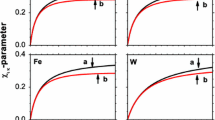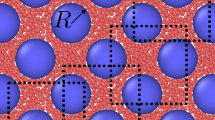Abstract
Equations of state of condensed species and air filling the pore space and an equation of state of the mixture are presented in a unified manner (in the form of the Mie-Grüneisen equation). Applicability of such an equation of state for air in the range of high pressures and temperatures is validated by comparisons of shock adiabats calculated with the use of this equation and available data in the literature. The thus-derived equation of state of a thermodynamically equilibrium mixture, which takes into account the characteristics of the species and their mass concentrations, offers a fairly accurate description of the behavior of a porous medium.
Similar content being viewed by others
References
R. K. Bel’kheeva, “Thermodynamic equation of state used to describe the behavior of a copper-graphite-air mixture under high pressures and temperatures,” in: V. M. Fomin (ed.), Modeling of Gas-Dynamics and Power-Engineering Processes [in Russian], Inst. Theor. Appl. Mech., Novosibirsk (1985), pp. 231–235.
G. M. Lyakhov, Fundamentals of Explosion Wave Dynamics in Soils and Rocks [in Russian], Nedra, Moscow (1974).
S. Z. Dunin and V. V. Surkov, “Structure of a shock wave front in a porous solid,” J. Appl. Mech. Tech. Phys., 20, No. 5, 612–618 (1979).
R. I. Nigmatulin, Fundamentals of Mechanics of Heterogeneous Media [in Russian], Nauka, Moscow (1978), pp. 48–51.
R. K. Bel’kheeva, “Mathematical modeling of the behavior of multispecies mixtures by a composite equation of state,” in: V. O. Kaledin (ed.), Boundary-Value Problems and Mathematical Modeling [in Russian], Novokuznetsk Department of the Kemerovo State University, Novokuznetsk (2004), pp. 45–47.
K. P. Stanyukovich (ed.), Physics of Explosion [in Russian], Nauka, Moscow (1975).
A. S. Predvoditelev (ed.), Tables of Thermodynamic Functions of Air [in Russian], Vols. 1–3, Izd. Akad. Nauk SSSR (1959).
S. P. Marsh (ed.), LASL Shock Hugoniot Data, Univ. of California Press, Berkeley (1980).
N. L. Coleburn, “The compressibility of pyrolytic graphite,” J. Chem. Phys., 40,No. 1, 71–77 (1964).
M. N. Pavlovskii and V. P. Drakin, “On the metallic phase of carbon,” Pis’ma Zh. Tekh. Fiz., 4, No. 5, 169–172 (1966).
R. G. McQueen and S. P. Marsh, “Hugoniots of graphites of various initial densities and equation of state of carbon,” in: Proc. Symp. on the High Dynamic Pressure, IUTAM, New York (1968), pp. 207–216.
A. M. Staver, “Studying thermodynamics of the phase transition of graphite to diamond under shock loading of carbon+metal mixtures,” in: Detonation. Critical Phenomena. Physicochemical Transformations in Shock Waves [in Russian], Chernogolovka (1978), pp. 131–136.
Author information
Authors and Affiliations
Additional information
__________
Translated from Prikladnaya Mekhanika i Tekhnicheskaya Fizika, Vol. 48, No. 5, pp. 53–60, September–October, 2007.
Rights and permissions
About this article
Cite this article
Bel’kheeva, R.K. Thermodynamic equation of state used to describe the behavior of a porous mixture under high pressures and temperatures. J Appl Mech Tech Phys 48, 664–670 (2007). https://doi.org/10.1007/s10808-007-0085-9
Received:
Revised:
Issue Date:
DOI: https://doi.org/10.1007/s10808-007-0085-9




